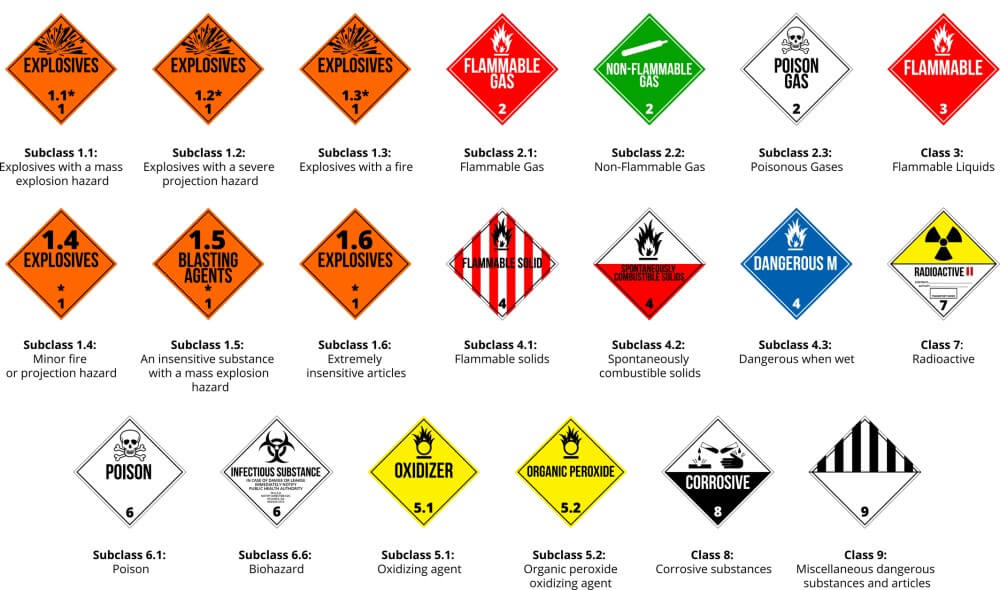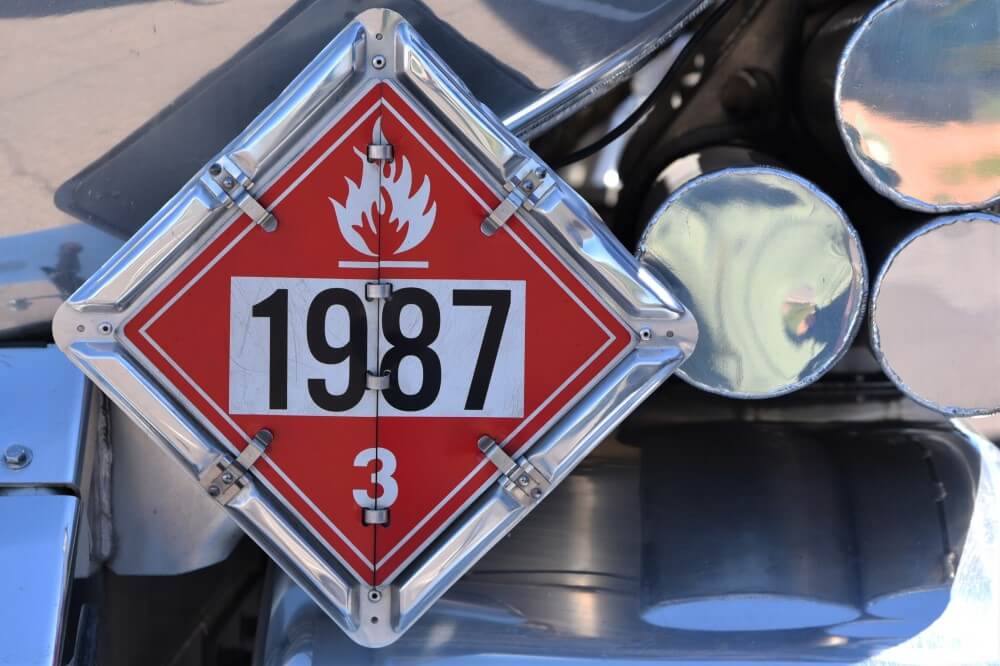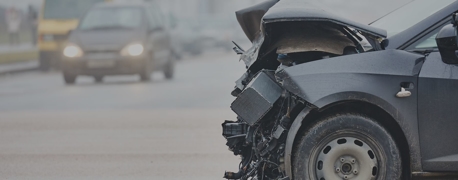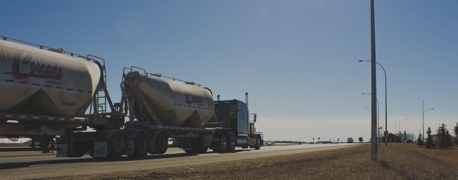What’s Inside That Semi? Understanding Trucking Hazmat Signs

Have you ever wondered what’s inside a tractor-trailer as you passed it on the road? Truck is by far the most prevalent method of shipping goods in the United States. Every year, commercial trucks transport more than 70% of all commodities shipped nationwide. In 2021, that amounted to 10.93 billion tons of freight. About two-thirds of these commercial trucks are not company-owned. They are for-hire vehicles, which means they may be hired by various companies to transport any manner of goods.
Commercial trucks can carry anything from livestock to cars, which are two of the easiest types of cargo to identify. Unless a truck is company-owned and displays its logo, you probably won’t know what it is carrying unless you sneak a peek at its manifest or look inside the trailer itself.
Most of the time, it’s not necessary for the average person to know what’s inside a semi-truck. We might be curious, but the answer is not likely to have a significant impact on our lives in any way—unless that truck is carrying hazardous materials.
Trucks are the primary mode of transportation for hazardous materials, or hazmat. According to the Bureau of Transportation, trucks were used to transport 1.81 billion tons of hazardous materials in 2017. That’s an astonishing amount of cargo, far exceeding the 679.8 million tons transported by pipeline, the 304.2 million tons transported by water, and the 90.4 million tons transported by rail.
With so much hazardous cargo on the road at any given moment, strict regulations must be implemented for everyone’s safety. The Department of Transportation (DOT) and Federal Motor Carrier Safety Administration (FMCSA) have precise requirements regarding the hazmat signs, or placards, that must be placed on tractor-trailers and tanker trucks to help a person quickly identify what cargo is being carried and how much of a risk of explosion, fire, or toxicity it may pose.
Hazardous Materials (HAZMAT) Defined
The DOT requires hazardous materials to be properly classified, packaged, labeled, and transported for the safety of workers, emergency responders, and the general public. The word “hazmat” might first suggest explosive or toxic substances like gasoline or chemicals, but more common and even household items can be considered hazardous materials and are therefore regulated.
The following are considered hazardous materials:
- Household cleaners
- Hairspray
- Spray paint
- Disinfectants
- Alcohols
- Ammunition and gunpowder
- Bleach
- Stoves and lanterns
- Batteries (car and lithium)
- Consumer electronics
- Dry ice
- Carbon dioxide
- Fertilizers
- Fireworks
- Fragrances and essential oils
- Hand sanitizer
- Insecticides
- Lighters and matches
- Nail polish remover
- Paint and paint thinner
- Smoke detectors
- Oxygen tanks
- Liquid nitrogen
- Swimming pool chemicals
- Gasoline and diesel fuel
- Propane
- Kerosene
- Sealants, varnishes, and stains
Hazmat Placards on Trucks: What Do They Mean?
Hazmat placards offer the fastest and easiest way to know what’s inside a truck. Emergency responders, for example, can identify whether a truck contains hazardous materials (and what type) in order to properly respond in the event of a trucking accident, fire, or other incident.
These diamond-shaped placards must be at least 250 mm (9.84 inches) on all sides.
Hazmat placards can be broken down into six main parts:
One: The Hazard Class Number
This is located in the bottom corner of the sign and indicates the class and division of hazardous material.
The class and division numbers are as follows:
1: Explosives
- 1.1: Potential to create mass explosion
- 1.2: Potential to create projectile hazard
- 1.3: Potential to create fire or minor blast
- 1.4: No significant blast risk
- 1.5: Used as blasting agent; very insensitive
- 1.6: No risk to create mass explosion
2: Gases
- 2.1: Flammable
- 2.2: Nonflammable
- 2.3: Toxic
3: Flammable & Combustible Liquids
4: Flammable Materials
- 4.1: Flammable solids
- 4.2: Spontaneously combustible
- 4.3: Dangerous when wet
5: Oxidizer & Organic Peroxide
- 5.1: Oxidizing substances
- 5.2: Organic peroxides
6: Poisons
- 6.1: Toxic
- 6.2: Infectious
7: Radioactive
8: Corrosive
9: Miscellaneous
Two: The UN/NA Number
This four-digit number helps shippers identify the type of material that’s being transported. 1090, for example, is the UN number for acetone.
- UN (United Nations) numbers are used to identify hazardous international cargo in the United States and will range from 0004-3534.
- NA (North American) numbers are used for goods that aren’t classified or regulated by the United Nations and will range from 8000-9279.
A complete list of UN numbers can be seen here.
Three: Compatability Group Letters
These letters indicate which compatibility group an explosive belongs to, which helps shippers and carriers determine best practices for transporting and storing such materials along with other explosives. There are 13 compatibility letters: A, B, C, D, E, F, G, H, J, K, L, N, and S.
A complete list of compatibility groups can be viewed here.
Four: Colors
The most obvious way to identify a hazmat placard is by its color:
- Orange is used for Class 1 hazmat and indicates it is an explosive material.
- Red is used for Class 2 and 3 materials that are flammable.
- Green is used for Class 2 materials that are not flammable.
- Yellow is used for Class 2 or 5 materials that are oxidizers (if they mix with oxygen, they may combust).
- White is used for Class 2 or Class 6 poisonous or biohazardous materials.
- Blue is used for Class 4 materials that are dangerous when wet.
- Half red and half white is used for Class 4 substances that are spontaneously combustible and may ignite when exposed to air.
- Red and white vertical stripes indicate Class 4 flammable solids.
- Red and yellow are used for Class 5 division 2 substances (organic peroxides) that have the potential to explode or ignite.
- Yellow and white represent Class 7 radioactive materials.
- Half white and half black represents Class 8 corrosive substances.
- White with black vertical stripes indicates Class 9 miscellaneous hazardous substances.
Five & Six: Words & Graphics
Hazmat placards may also contain specific words and pictures to indicate the type of cargo. A fire graphic, for example, indicates that a substance is flammable. An “O” with flames indicates combustibility if mixed with oxygen. The words “infectious substance” with a biohazard symbol of three circles overlapping a center circle are used for biohazards. A skull and crossbones image is used for poisonous substances.
The following image shows examples of hazmat placards with the color, image, and class number. The UN/NA number would typically appear in the center of the sign.

Test Your Knowledge!
Let’s look at a real-life example of a hazmat placard to see what substance that truck might be carrying:


Based on this image, we can see that it is a red sign and a Class 3 substance, making it a flammable and combustible liquid. The graphic at the top of the placard is a further indication of its flammability. With a UN number of 1987, this truck is carrying “alcohols, NOS.”
NOS (not otherwise specified) means that the exact technical name for the type of alcohol the truck is carrying is not shown on the Hazardous Materials Table. The cargo is therefore given the number corresponding class, packing group, and the name that most appropriately describes it.
What If a Truck Has More than One Sign?
It’s not uncommon to see a truck with multiple hazmat placards. If you see one, this means that the truck is transporting more than one type of hazardous material. There are, however, numerous restrictions in place regarding what materials can be transported by the same vehicle.
Do All Trucks Carrying Hazardous Materials Need Warning Signs?
According to CFR §172.504, vehicles must have the appropriate hazmat placards affixed to both sides and both ends of the trailer or tank carrying the hazardous material. Whether a truck requires hazmat placards depends upon the type of material it is carrying and the amount.
Hazardous materials are separated into two tables. Table 1 includes the more volatile classes of explosives (1.1, 1.2, and 1.3), poison gas (2.3), dangerous when wet (4.3), organic peroxide (5.2), poisonous when inhaled (6.1), and radioactive (7). All other classes of hazardous materials are included in Table 2.
If a truck is carrying any hazardous material, it must have the appropriate placard so the substance can be easily identified. The only exception is a truck carrying less than 1,001 pounds of a Table 2 hazardous material.
Sharing the Road with a Truck Hauling Hazardous Cargo
When you think about the fact that a tractor-trailer or tanker truck could be carrying anything from children’s toys to radioactive materials, it can be a bit concerning. The FMCSA has strict rules regarding hazmat transportation, such as requiring safety inspections before and during every trip, avoiding heavily populated areas (if possible), and parking more than 300 feet from workplaces, homes, and bridges. Like hazmat placard requirements, these rules are in place to protect every person who could be injured if there was an incident involving the truck or its cargo.
If you see a truck with hazmat warnings, you might want to give it a little extra attention and space. If you see one involved in an accident, it may be safer to keep your distance while calling 911—depending on the cargo. Knowing the signs and what they mean can help you be more prepared, no matter what.
- Categories


